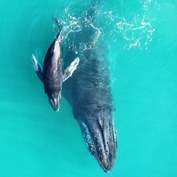Murdoch University Cetacean Researchers are using aerial images to access baleen whales
Murdoch University Cetacean Research Unit researcher Dr. Fredrik Christiansen; in collaboration with Professor Lars Bejder, is developing a research project to improve our understanding of baleen whale body condition and reproduction by using novel non-invasive technology.
The study, funded by Murdoch University, involves using an Unmanned Aerial Vehicle (UAV) to capture unique aerial imagery of humpback whales and is a first in Australia. The images are then used to measure seasonal changes in body condition of free-living humpback whales in the Exmouth Gulf and its influence on calf growth and condition.
"Little is known about the link between body condition and reproduction in large whales, which makes it difficult to monitor the health of baleen whale populations," said Dr Christiansen.
Baleen whales are some of the largest mammals on earth including the blue, minke, right and humpback whale species. Dr Christiansen says that current practices for measuring these whales were not suitable for vulnerable populations.
"Methods to assess body condition in free-living whales are scarce so there is a need to develop and test new methods to measure body condition in large whales," he said.
"This study looks at the feasibility of using UAVs to take aerial shots of whales, from which body condition can be assessed."
The method of using the highly complex UAV to measure humpback whales has never been done before on this particular baleen whale population.
The study targeted females with calves that enter Exmouth Gulf during August through to October. The sheltered bay serves as an important resting and nursing ground for the whales during their southern migration back from their breeding grounds in the Kimberley.
"We want to see how the body condition of the females relates to that of the calves. So if the females are in poor body condition, are they having calves that are also of poor body condition? That is what we are particularly interested in finding out," continued Dr Christiansen.
The ability to monitor the body condition of the humpback whale population is extremely valuable, as it allows researchers to make global comparisons between baleen whale populations.
"In the future we can compare the west coast of Australia to the east coast and also to other populations globally. You can also look at the body condition of whales over time in relation to productivity in Antarctica, their feeding ground," Dr Christiansen said.
Provided by Murdoch University
























